Last updated on May 30th, 2023 at 06:26 pm
Types of Financial Analysis
Several companies use different Types of financial analysis both internally and externally. These analyses are a great way for any business to evaluate its financial stability, and for investors to evaluate whether or not your company is a worthy investment. In this article, we will define financial analysis and describe the various types of financial analysis.
What is Financial Analysis?
Financial Analysis is the process of evaluating any business project company by digging deep into its finances. Financial analysis is used to determine the performance and sustainability of the company/ business. Financial analysis is used to analyze whether an entity, business, or company is profitable enough to warrant a monetary investment. The job of a financial analyst includes evaluating trends, setting financial policies, build long term plans for business-related activities, identifying investment opportunities, determining the stability, solvency and liquidity of a company, etc. The analyst will thoroughly examine and analyze the company’s financial statement – Income statement, balance sheet and cash flow statement. Financial analysis can be conducted from the perspective of both corporate finance and investment finance as well [1].
One of the most common ways of analysis is to calculate various ratios using the financial statements like Return of Equity (ROE), Earnings per Share (EPS), P/E ratio, Debt to equity ratio, Return on Capital Equity (ROCE), etc [2].
Types of Financial Analysis
Here are the top 5 types of financial analysis:
- Horizontal Analysis:
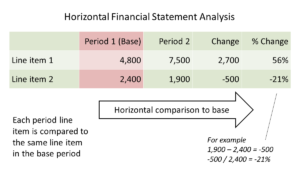
[3]Horizontal Analysis is used to compare data such as ratios or line items over a number of accounting periods (yearly or quarterly). It can either use absolute comparisons of percentage comparisons. It measures the line of the financial statement of items with the base year. This helps in analyzing the growth of the company from Year on Year (YoY) or quarter to quarter. The downside of this analysis is that if the industry is downgrading and still the company is performing better, the trend analysis will show negative growth of the company.
- Vertical Analysis:
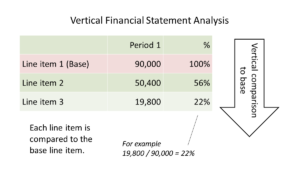
[4]Vertical analysis is the proportional analysis of a financial statement, where each line item on a financial statement is listed as a percentage of another item. The vertical analysis allows proportional analysis of the data. The vertical analysis helps in comparing the entities of different sizes, as it presents the financial statements in absolute form. It represents the data of a single period only, so there can be miss comparison across different time periods.
- Trend Analysis:
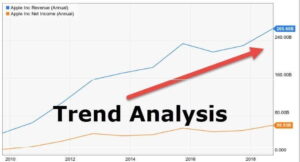
Trend analysis is a way of collecting data and attempting to find a pattern in it. It helps in predicting the future movement that is based on the current ongoing trend. Trends give a brief idea about what has happened in the past and their job is to predict what could happen in the future. Some common terms used in trend analysis are Trendlines, Chart patterns, Indicators, Moving Averages, etc. It analyses the price movement and trade volume.
- Profitability Analysis:
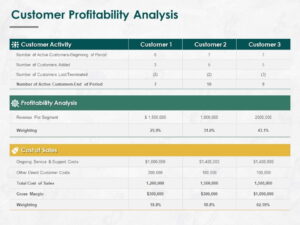
Profitability analysis is an analysis of the profitability of the company or business. Profitability analysis allows companies to maximize their profits, resulting in maximising the opportunities that businesses can take advantage of, in order to continue growing in an extremely dynamic and competitive market. This type of analysis helps in identifying fast/slow moving stocks, market trends, growth opportunities, etc. Ultimately, this helps in the decision making to see a more concrete picture of the business as a whole.
- Liquidity Analysis:
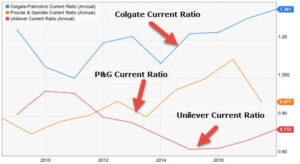
[5]Liquidity analysis uses ratios to determine whether or not a company will be able to pay back any debts or other expenses. This type of analysis is helpful because if a business isn’t able to pay off its liabilities, they’re bound to face financial troubles in the upcoming future. Liquidity analysis is particularly helpful for lenders or creditors who want some insight into your financial standing before offering you a loan or credit. Various ratios such as the cash ratio and current ratio are used in a liquidity analysis.
Conclusion
Financial analysis determines a company’s health, stability, and performance which provides an understanding of how the company conducts its business. It is important to know that financial statement analysis has its limitations as well. Different accounting methods adopted by different firms change the visible health and profit levels for either better or worse. Different analysts may get different results from the same information. Hence, we must conclude that financial statement analysis is only one of the tools (although a major one) while taking an investment decision.


